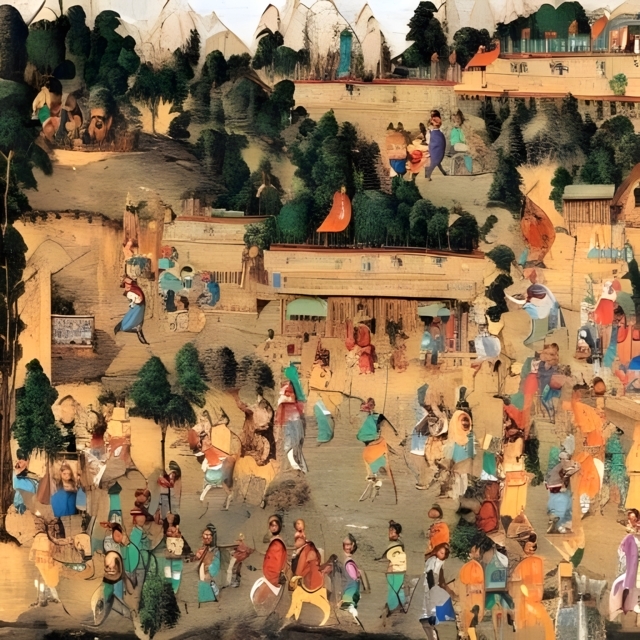The Gorkha Kingdom was a member of the Chaubisi rajya, a confederation of 24 states on the Indian subcontinent ruled by the Khas people. In 1743 CE, the kingdom began a campaign of military expansion, annexing several neighbours and becoming present-day Nepal. ¹
But how did this small hill principality rise to such prominence and power? What were the origins and motivations of its rulers and warriors? In this blog post, we will explore the history and culture of the Gorkha Kingdom, from its foundation in 1559 CE to its unification of Nepal in 1768 CE.
Birth of a Kingdom
The name Gorkha or Gorkhali derives from the medieval Hindu warrior-saint Guru Gorakhnath, who has a historic shrine in Gorkha District. The word itself means “protector of cows”, a sacred animal in Hinduism.
The founder of the Gorkha Kingdom was Prince Dravya Shah, second son of King Yasho Brahma Shah of Lamjung Kingdom. He was not in line to inherit his father’s throne, so he decided to carve out his own domain. He replaced the Khadka chiefs who previously ruled the region and established his capital at Gorkha Darbar, a hilltop fortress.
Dravya Shah was a visionary leader who consolidated his power by forging alliances with other Khas chiefs and expanding his territory through conquest and diplomacy. He also promoted Hinduism as the state religion and patronized Brahmin priests and scholars. He ruled from 1559 CE to 1570 CE and was succeeded by his son Purna Shah.
Rise of a Dynasty
The Gorkha Kingdom was ruled by the Shah dynasty, which traced its ancestry to Rajput clans of India. The dynasty produced several remarkable kings who continued the legacy of Dravya Shah and transformed Gorkha into a formidable force in the region.
One of them was Ram Shah, who ruled from 1609 CE to 1633 CE. He was known for his justice and wisdom, which earned him the epithet of Nyayadhish, or “the judge”. He introduced a legal code called Muluki Ain, which regulated social and moral conduct. He also built temples, roads, bridges and irrigation systems. He was succeeded by his son Dambar Shah, who ruled from 1633 CE to 1645 CE.
Another notable king was Prithvi Narayan Shah, who ruled from 1743 CE to 1768 CE. He is regarded as the founder of modern Nepal, as he unified the various kingdoms and principalities under his rule. He was a visionary and ambitious leader who dreamed of creating a strong and independent nation in the Himalayas. He also sought to protect his kingdom from the encroachment of the British East India Company, which had colonized much of India.
Prithvi Narayan Shah launched a series of wars against his neighbours, starting with Nuwakot in 1744 CE. He faced fierce resistance from the Malla kings of Kathmandu Valley, who formed an alliance against him. He also fought against Tibetans, who invaded his northern borders. He eventually conquered Kathmandu Valley in 1768 CE after a series of bloody battles. He moved his capital from Gorkha to Kathmandu and declared himself Maharajadhiraja, or “sovereign king” of Nepal. He died in 1775 CE and was succeeded by his son Pratap Singh Shah.
Legacy of a Kingdom
The Gorkha Kingdom left a lasting impact on the history and culture of Nepal. It established a unified Nepali identity and language, based on the Khas dialect spoken by the Gorkhas. It also fostered a sense of nationalism and pride among the Nepalis, who resisted foreign domination for centuries.
The Gorkha Kingdom also gave rise to the Gurkhas, the legendary soldiers who fought for various armies around the world. The Gurkhas were originally recruited by the British East India Company during the Anglo-Nepalese War (1814-1816), which resulted in the loss of some territories for Nepal. The Gurkhas impressed the British with their bravery and loyalty, and were hired as mercenaries. They have since served in the British Army, the Indian Army, the Singapore Police Force, the Brunei Army and the UN peacekeeping forces. They are known for their khukuri, a curved knife, and their motto: “Better to die than be a coward”.
The Gorkha Kingdom was a remarkable example of a small state that rose to greatness through courage and determination. It shaped the destiny of Nepal and its people, having left a lasting mark on the world.
References
– Gorkha Kingdom – Wikipedia. https://en.wikipedia.org/wiki/Gorkha_Kingdom
– Gurkha – Wikipedia. https://en.wikipedia.org/wiki/Gurkha
– Gorkha Kingdom | Military Wiki | Fandom. https://military-history.fandom.com/wiki/Gorkha_Kingdom.
Tags
Divi Meetup 2019, San Francisco
Related Articles
Unappreciated Greatness
Life and Legacy of Jahangir of the Mughal Empire. Jahangir ruled over one of the largest empires in human history during his lifetime, yet few people outside of South Asia have heard of him. I aim to shed light on the life and legacy of this remarkable figure,...
The Plague Doctor’s Diary
A Personal Account of the Turin Epidemic of 1656. I am writing this diary to record my experiences and observations as a plague doctor in Turin, the capital of the Duchy of Savoy, during the terrible epidemic that has afflicted this city and its surroundings since the...
The Timeless Beauty of Bustan
Unveiling the Secrets of Saadi Shirazi's Masterpiece.In the realm of Persian literature, few works have captured the essence of love, spirituality, and morality quite like Bustan (The Orchard) by Saadi Shirazi. This 13th-century masterpiece has left a lasting impact...
Stay Up to Date With The Latest News & Updates
Explore
Browse your topics of interest using our keyword list.
Join Our Newsletter
Sign-up to get an overview of our recent articles handpicked by our editors.
Follow Us
Follow our social media accounts to get instant notifications about our newly published articles.









